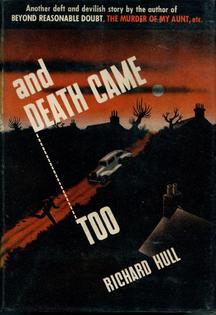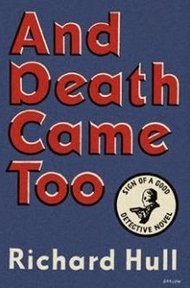
As DS Scoresby continues to investigate, with questionably competent help from Constable Reeves and the poaching-inclined Sergeant Evans, the clues start to accrue. An open book of legal code was found by the dead man’s chair, hardly a tome for light reading; a boy notices part of a license plate number from a car parked along a dark lane on the night of the murder; Gerald Mansley apparently lied about the bus stop he used during a visit to London; and Patricia Hands tells the police that a spring-loaded knife used for killing game – and belonging to her brother Martin – has disappeared. When a second murder occurs, the victim being a suspect-turned-blackmailer who knew too much, Scoresby calls everyone back to Y Bryn to present the facts and argue the case against the killer.
Review: To date, And Death Came Too is the eighth Richard Hull book (of his fifteen mysteries) that I have read. Interestingly, it is the first – and perhaps only – story of his that employs a classic whodunit structure, complete with the discovery of clues, suspects interviewed by a determined chief-inspector, and “the grand confrontation scene”, as the acerbic Mr. Salter puts it, wherein the killer is finally accused of the crime and revealed to the reader. Hull handles all aspects of this traditional format skillfully, and the result is a delight for mystery fans. Those unfamiliar with this author may wonder what exactly he has been delivering in his novels, if not a fair-play whodunit. The answer explains why I am attracted to Richard Hull’s writing in the first place: like Anthony Berkeley, he is an author who greatly enjoys playing with the conventions and architecture of the mystery form, finding new approaches to present a crime story and its cast of characters. Some take the guise of an inverted mystery, meaning that the reader knows the murderer and his goal from the start. Both The Murder of My Aunt and My Own Murderer give us immediate access to the criminally-minded narrators as they tell their stories.
Other Hull titles are sly variations on the whodunit, with smart satirical observations on class and corporate thinking. In the delightful Murder Isn’t Easy, we know that violence will strike the halls of the NeO-aD advertising agency, but it’s not certain until later who victim and killer might ultimately be. Keep It Quiet chronicles the efforts of a blackmailer (whose identity is revealed halfway through the book) who uses his power to affect changes to his liking at the social club he frequents. Such intriguing new approaches don’t always fully cohere – as with the amiable but muddled The Murderers of Monty, where a group of businessmen incorporate to plot the demise of an irritating co-worker – but they are enjoyable tales, and admirable in their invention.
In contrast, And Death Came Too seems to be simultaneously a genuine addition to the fair-play whodunit form and a winking comment on the genre. (The wink may be slight compared to Hull’s more caustic satire, but it is there.) Perhaps because of the author’s intention to deliver a traditional mystery, this book is one of only a few where Hull gives the police characters center stage. Even with his titles featuring Inspector Fenby, often the investigating officer is kept decidedly in the background. Here, DS Scoresby is the principal driver of the action, working with other officers and reporting to Major Flaxman as new evidence arises. Generous characterization is provided for major and supporting characters alike, allowing even secondary figures like the precise, egocentric housemaster Kinderson and the suspicious French servant Marie Lefevre to contribute to the story’s success.

 RSS Feed
RSS Feed